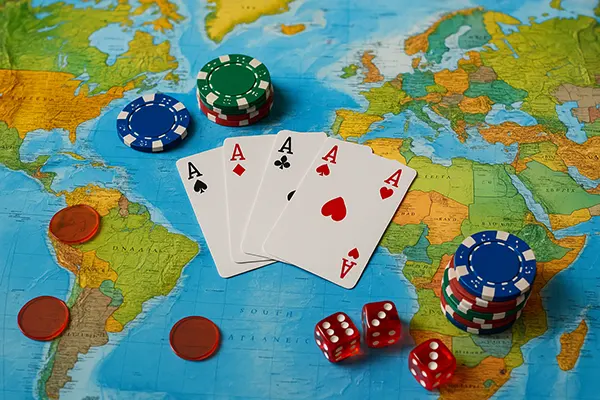
History of the WSOP: How the Tournament Became Poker’s Main Stage
The World Series of Poker (WSOP) has grown from a modest gathering in Las Vegas to the most prestigious and globally recognised tournament series in the poker world. Its development reflects both the evolution of the game itself and the professionalisation of competitive poker. Today, WSOP is synonymous with elite-level play, million-dollar prizes, and a pathway to international fame for countless players.
The Humble Beginnings of the WSOP
The origins of the WSOP date back to 1970, when Benny Binion, a casino owner in Las Vegas, invited seven of the top poker players to compete in a single event at his Horseshoe Casino. The idea was simple: determine the best poker player through a high-stakes showdown. The winner, Johnny Moss, was chosen by peer vote and awarded a silver cup—an unassuming start for what would become a poker empire.
In the following years, the format changed to a freezeout tournament, where the last player standing would win the entire prize pool. This shift marked the beginning of the WSOP as we know it. By 1971, the event had grown to five tournaments, and interest began to build outside Nevada. Players like Doyle Brunson and Amarillo Slim helped popularise the competition through media appearances and poker literature.
By the 1980s, satellite tournaments enabled lower-stakes players to earn seats at the WSOP Main Event. This innovation not only expanded participation but helped grow poker as a serious competitive endeavour. The poker boom had officially begun, and the WSOP was leading the charge.
Landmark Moments That Shaped the Series
One of the most iconic events in WSOP history occurred in 2003 when amateur player Chris Moneymaker won the Main Event after qualifying through a $39 online satellite. His victory ignited a global poker boom, proving that anyone could win big. Dubbed the “Moneymaker Effect,” this moment brought online poker into the mainstream and sent WSOP participation numbers soaring.
Another critical point in WSOP’s growth was its acquisition by Harrah’s Entertainment in 2004. The company expanded the tournament’s footprint and enhanced its marketing, broadcasting, and prize structures. The Main Event prize pool surged past $10 million, attracting thousands of players from over 100 countries.
The launch of the WSOP Europe in 2007 and later the WSOP Asia-Pacific further solidified the brand’s global dominance. These international editions introduced bracelet events on new continents, giving players worldwide the chance to compete without travelling to Las Vegas.
Modern WSOP: The Digital and Live Hybrid
Today, the WSOP is a blend of tradition and innovation. While the annual Las Vegas series remains the crown jewel, digital platforms have extended access to a broader audience. Since 2015, WSOP.com has hosted official bracelet events online, making it possible for players to compete from home while still earning the game’s highest honour.
In response to the global COVID-19 pandemic, the 2020 edition of WSOP pivoted to an online-only format, with partnerships on platforms like GGPoker allowing international players to take part. This temporary change demonstrated the adaptability of the series and introduced new audiences to high-level poker.
As of February 2025, the WSOP offers over 100 events across various disciplines—Texas Hold’em, Omaha, Stud, and Mixed Games—catering to both professionals and recreational players. With live and online participation continuing to rise, the WSOP remains the most ambitious and inclusive poker series in history.
Prestige, Prizes, and Player Recognition
Winning a WSOP bracelet is the pinnacle of poker success. For many professionals, it’s not just about the money—it’s about legacy. The most successful players, such as Phil Hellmuth (17 bracelets as of 2025), are celebrated as legends of the game, and each year brings new names into the fold.
The WSOP Main Event remains the most coveted tournament, often with a buy-in of $10,000 and life-changing payouts. The winner earns not only millions of dollars but also global fame and a place in poker history. The event’s final table, often dubbed the “November Nine,” is broadcast worldwide and reaches millions of viewers.
Aside from the Main Event, the WSOP also includes events for seniors, women, and low-stakes players, reinforcing its commitment to inclusivity and diversity in poker. These tournaments offer the same world-class structure and prizes while encouraging a broader range of players to compete on the biggest stage.

WSOP’s Influence on the Global Poker Ecosystem
The impact of the WSOP goes beyond its tournaments. The series has helped shape the modern poker economy, influencing game theory, sponsorship deals, and the popularity of televised poker. With increased visibility, more players are turning to the game professionally, and poker education has become an industry of its own.
Broadcasts of WSOP events, particularly through ESPN and PokerGO, have helped demystify the game and present it as a test of skill and mental fortitude. Hole card cameras and expert commentary have made poker more accessible to fans and aspiring players alike.
Moreover, the WSOP serves as a benchmark for other global poker events. Many national series model their structures on WSOP standards, and the prestige of winning a bracelet often overshadows even larger prize pools from competing events. The tournament has effectively set the gold standard for professional poker.
The Road Ahead: Future of the WSOP
Looking forward, the WSOP continues to embrace innovation. Plans for integrated mobile apps, VR experiences, and even blockchain-based tournament entries are under discussion. These advancements could redefine how players enter, experience, and follow poker competitions.
Live tournaments will remain at the heart of the WSOP, but digital growth will likely drive future expansion. Online qualifiers, real-time hand analysis, and decentralised payouts are poised to enhance player experience while preserving the game’s integrity and competitiveness.
As it enters its sixth decade, the WSOP shows no signs of slowing down. What started as a single-table contest among friends is now a global institution—respected, followed, and revered by poker players everywhere. The next chapter promises to be just as thrilling as the last.






